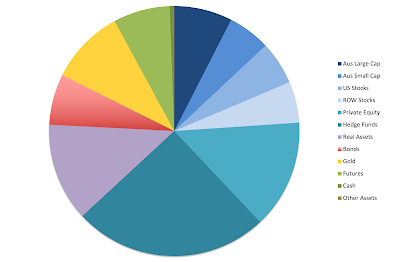Venture capital returns won't be reported for another month, but I expect them to be flat, so that the final numbers are not far from what they are now. In December, stock markets fell. The MSCI World Index (USD gross) lost 3.90%, the S&P 500 5.76% in USD terms, and the ASX 200 3.13% in AUD terms. All these are total returns including dividends. The Australian Dollar rose from USD 0.6788 to USD 0.6816. We lost 1.24% in Australian Dollar terms or 0.83% in US Dollar terms. The target portfolio is expected to lose 2.43% in Australian Dollar terms and the HFRI hedge fund index around 1.3% in US Dollar terms. So, we out-performed all benchmarks.
Here is a report on the performance of investments by asset class:
The asset class returns are in currency neutral returns as the rate of return on gross assets. I have added in the contributions of leverage and other costs and the Australian Dollar to the AUD net worth return.
Only gold and private equity had positive returns. Gold was the biggest contributor to returns and hedge funds the greatest detractor.
Things that worked well this month:
- Gold gained AUD 14k and Pengana Private Equity (PE1.AX), 9k.
What really didn't work:
- Regal Funds (RF1.AX) lost AUD 12k followed by Hearts and Minds (HM1.AX) and Tribeca Global Resources (TGF.AX), which each lost 10k.
The investment performance statistics for the last five years are:
The first three rows are our unadjusted performance numbers in US and Australian dollar terms. The MSCI is reported in USD terms. The following four lines compare performance against each of the three indices over the last 60 months. The final three rows report the performance of the three indices themselves. We show the desired asymmetric capture and positive alpha against the ASX200 and the MSCI but not against the hedge fund index. We have a higher Sharpe Index than the ASX200 but lower than the MSCI in USD terms. We are performing about 2.5% per annum worse than the average hedge fund levered 1.7 times. Hedge funds have been doing well in recently.
We are now very close to our target allocation. Our actual allocation currently looks like this:
About 70% of our portfolio is in what are often considered to be alternative assets: real estate, art, hedge funds, private equity, gold, and futures. A lot of these are listed investments or investments with daily, monthly, or quarterly liquidity, so our portfolio is not as illiquid as you might think.
We receive employer contributions to superannuation every two weeks. We are now contributing USD 10k each quarter to Unpopular Ventures Rolling Fund and less frequently there will be capital calls from Aura Venture Fund II. In addition, we made the following investment moves this month:
- I bought 1,000 shares of PMGOLD.AX.
- I tried to do a trade with around 12k shares of Regal Funds (RF1.AX). It wasn't successful.
- I closed a tiny position of WLS.AX shares pending the merger of WLS into WCMQ.AX.
- The remainder of our WLS shares will convert to WCMQ and our URFPA shares will convert to URF at the turn of the year.





















